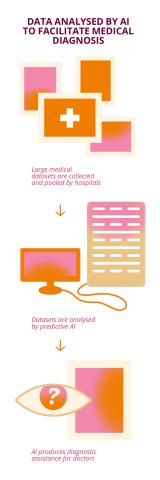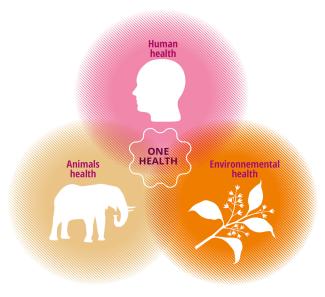
Environment, animals, humans: The one health approach
This article is an extract from L'Édition n.22.
At Université Paris-Saclay, healthcare is ahead of its time, with research topics as varied as pollinator conservation or managing data with artificial intelligence. Human beings don't live in a goldfish bowl. The environment in which they are immersed is fraught with dangers (often resulting from human activity): air and water pollution, repeated global pandemics, exposure to carcinogens and long summer heat waves are all causes of mortality.
The fact that our environment is full of dangers for human beings means rethinking medicine through the "one health" approach, which simultaneously study and preserve human, animal and plant health ecosystems and biodiversity. Scientists are promoting urgent action to keep the world liveable, including the fight against climate change, the detection of zoonoses, diseases carried by animals such as mosquitoes and transmitted to humans and the consideration of socioeconomic aspects such as the cost of medicines.
Bees under pressure
The "one health" approach also means protecting biodiversity, particularly that of pollinators, the animals that carry pollen grains from one flower to another and are involved in the sexual reproduction of many plant species. Over the past twenty years, bee colony collapse disorder has been decimating beehives worldwide. "Bee mortality is reaching a worrying and widespread level," stresses Fabrice Requier, research fellow in agroecology at the Evolution, Genome, Behavior and Ecology Laboratory (EGCE - Univ. Paris-Saclay, CNRS, Research Institute for Development IRD). Pesticides, neonicotinoids, the disappearance of natural foraging areas, invasive pests... There are multiple causes of this collapse. "It's a devastating cocktail effect for pollinators, especially honeybees, which we've selected over millennia for their productivity and non-aggressiveness, to the detriment of their resilience." In the early part of his career, the ecologist worked on Apis mellifera bees, our domestic honey bees, which he studied from every angle. "For example, we developed a field test that is now used for pesticide approval. Foraging bees are offered a mixture of sugar and pesticide. If they're not harmed, they're able to return to their hive without any problems, otherwise it's proof that they've been poisoned." He also assesses the influence of parasites, pathogens and viruses on bee health. The most studied, the varroa mite, is a virus-carrying parasitic mite that infiltrates the hive and causes premature mortality. The Asian hornet is also dangerous: "After arriving in France in 2004, it attacks bees as they leave the hive, encouraging them to take refuge inside for days on end, to the detriment of food storage for the winter," notes the researcher.
Even more worryingly, honeybee mortality is just the tip of the iceberg. Environmental pressures are also endangering the 20,000 other bee species, both domesticated and wild, as well as the 300,000 pollinating animal species. According to Fabrice Requier, it would be a serious mistake to ignore this issue: "Pollination is an ecosystem service, i.e. a benefit provided by nature. While the wind pollinates some staple crops, such as rice and wheat, other crops, like cocoa, are totally dependent on pollinators." Many crops, such as apples, tomatoes, avocados and oilseeds also make more moderate use of pollinators. "But that doesn't mean they can do without them," says the ecologist. Wind-pollinated strawberries are smaller and more irregular in shape. "It is estimated that in a world without insects, the yield of these plants would halve, and the nutritional quality of the fruit would be lower."
"If the decline continues, essential vitamins and minerals may disappear from many people's diets." The researcher and his team fear the emergence of iron and vitamin A deficiencies in developing countries, where dietary diversity is already fragile. "We could be witnessing an increase in malnutrition and disease affecting nearly 71 million people," warns the researcher.
In Kenya, where Fabrice Requier is about to work with a local university, there are some vast avocado monocultures. "Farmers use high doses of insecticides, creating veritable deserts of biodiversity, with no pollinators," laments the researcher. To give bees some respite, we need to curb the use of pesticides everywhere and increase the number of hedges and grassy strips, which act as refuges for wild pollinators. This would then protect chocolate, the nutritional quality of fruit and global health.

How is health data analysed?
Medical research deals with huge quantities of data, a volume necessary for robust statistical analysis. This creates the challenge of analysing the information in the right way. In response, proponents of the "one health" approach are relying on multidisciplinarity.
During the Covid-19 pandemic, the pooling of observations by hospitals and laboratories provided reliable data for monitoring the epidemic and guiding public policy. In order to repeat such achievements in other areas of health, Bertrand Thirion, Director of Research of the Inria-CEA Models and Inference for Neuroimaging Data (MIND) project team, is calling for a close working relationship between disciplines: "To develop sustainable health, we need to be proactive and call on specialists capable of managing, organising and analysing data, especially using artificial intelligence (AI)."
After contributing to the development of the Scikit-Learn general-purpose machine learning tool, the researcher is now focusing his research on the neurosciences. His team processes large datasets using predictive AI. "We create models capable of making a diagnosis from complex data, such as magnetic resonance imaging (MRI) scans. Some models can predict your age from a simple snapshot of your brain. Others diagnose cancers by analysing images of organs." The MIND project team is keen to make the process transparent: "To demonstrate precision, we need to build algorithms able to accompany their response with a confidence interval, and point to the area of the image on which their diagnosis is based," argues the researcher.
Creating complete athletes
Bertrand Thirion also stresses the importance of dialogue with healthcare personnel to identify real needs: "The predictions we can make are only relevant if they are useful to doctors in improving their care.” However, the researcher reminds us of the need for perspective in the face of the many promises heralded by the use of AI. "The current trend is to create models that are almost always right in the test phase." During this phase, data scientists calculate a prediction score by testing the model on one of the few large datasets available for research. "However, by using only a few datasets for training and evaluation, the risk is to create over-specialised algorithms, the performance of which is not guaranteed when faced with real data, especially if these are imprecise, sometimes incomplete hospital data." For example, an Olympic swimmer who dedicates all their training to swimming lengths will finish last if they have to take part in a pole-vaulting event. Instead, the challenge is to create versatile athletes who can perform in a wide variety of contexts. "Research data must be made free and public to create more databases and facilitate our work," concludes the researcher.
In order to predict the global health challenges of the 21st century, pollinators, biodiversity, agriculture, pollution, climate change and many other parameters need to be taken into account. Soon, you won't have to ask your doctor for a simple check-up, but rather how the bees and artificial intelligences in your area are doing.
References:
- Requier F., et al., Bee and non-bee pollinator importance for local food security, Trends in Ecology & Evolution, Volume 38, Issue 2 (2023)
- Mandonnet E., Thirion B., Tackling the Complexity of Lesion-Symptoms Mapping: How to Bridge the Gap Between Data Scientists and Clinicians? Machine Learning in Clinical Neuroscience. Acta Neurochirurgica Supplement, vol 134 (2022)


